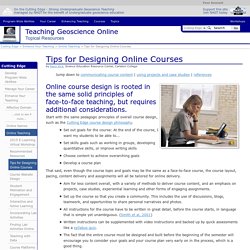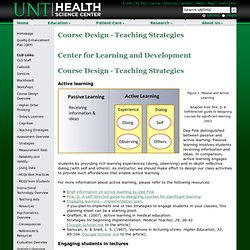

Principles of Online Design. Tips for Designing Online Courses. By Karin Kirk, Science Education Resource Center, Carleton College Jump down to communicating course content | using projects and case studies | references Online course design is rooted in the same solid principles of face-to-face teaching, but requires additional considerations.

Start with the same pedagogic principles of overall course design, such as the Cutting Edge course design philosophy. Set out goals for the course: At the end of the course, I want my students to be able to... Set skills goals such as working in groups, developing quantitative skills, or improve writing skills Choose content to achieve overarching goals Develop a course plan That said, even though the course topic and goals may be the same as a face-to-face course, the course layout, pacing, content delivery and assignments will all be tailored for online delivery.
Traditional lecturing is replaced by a variety of multimedia communication tools. Simplifying Online Course Design. Written by: Rob KellyPublished On: September 7, 2012 Good course design is essential to effective online learning.

In an interview with Online Classroom, Richard Smith, associate professor and coordinator of the instructional technology program, and Caroline Crawford, associate professor of instructional technology, both at the University of Houston - Clear Lake, talked about online course design principles that can improve learning and minimize extraneous work on the part of the students and instructor. Don't try to do too much. A common mistake of new online educators is to include more content than is necessary, which takes more work to design and facilitate. "They tend to put too much content into the course. Smith recommends taking an online course to get a feel for what's appropriate.Keep the course organized and well labeled. "The more work that goes into the preparation means less work when the course is in progress.
Everything needs to be clearly labeled, Smith says. Design Your Course - Teaching Excellence & Educational Innovation. Guide to Online Course Design [INFOGRAPHIC] Today there are a countless number of tips and tricks when it comes to effective online course design, that it can become confusing where to start.
![Guide to Online Course Design [INFOGRAPHIC]](http://cdn.pearltrees.com/s/pic/th/online-infographic-learndash-66595867)
These theories can range from actionable steps to philosophical diatribes, both of which provide their use, but equally are confusing as to where to begin. Enter the “Guide to Online Course Design” infographic by MindFlash. This infographic outlines some of the key components to creating an online course. Naturally, not every item is an absolute necessary (many of which will depend on your needs), but they all do provide value for your online courses. More than ever, it is important that you encourage online interaction and feedback mechanisms for the students in the online courses. With the “bones” (software) in place, you can then begin the fun part: finding content for your course. BlogsWikisGroup Pages (Google)Discussion BoardsVimeoYouTubePowerPoint PresentationsWikisInternet Libraries. 52 - Considerations in Online Course Design. - Course Design - Teaching Strategies - UNTHSC.
Nine Events of Instruction How do you plan for a class?

How do you arrange all the activities in a class? One way to plan your class session is by following the Nine Events of Education advanced by educational psychologist Robert Gagne. Figure 2 is an illustration of the nine events of instruction: Figure 2. For an explanation of the Nine Events of Instruction, please visit the following resources: Bookend procedure Research has consistently shown that lecturing in the entire class period is not an effective way of teaching. Figure 3. Guidelines for Academic Online Courses – Faculty Resources – – Minnesota State University, Mankato. The purpose of the following information is to provide academic departments with a tool to assist in the development of online courses.

The decision of course readiness for online delivery is made by the academic department. Those guidelines are recommended for adoption by the Distance Learning Taskforce 12/07/2004. For more information, contact:Becky Copper-Glenz Dean, Extended Learning 116 Alumni Foundation CenterPhone: 507-389-1094Fax: 507-389-6379Email: ext@mnsu.edu Designing an online course In designing an online course, instructors must remember that technology is a tool, not a solution. Evaluation and Assessment in online courses Once a course is designed, good online courses need a method to determine if students are learning what is intended. Online Course Design Guidelines.